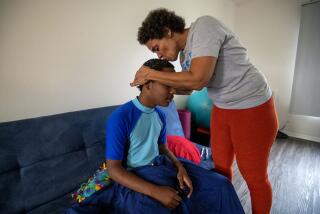Teen, and His Family, Find the Courage to Change
- Share via
John had agreed to talk about how his brief stay in an emergency shelter for troubled teens helped him turn his life around, but words didn’t come easily for this 16-year-old who once prided himself on his ability to lie convincingly.
Until he and his family started answering a reporter’s questions, John didn’t realize how painful it would be to remember the months of deceit and irresponsible behavior that finally pushed his mother to insist he leave home and get some counseling--or go to juvenile hall.
“It’s stuff I’ve tried to put behind me,” John said quietly during a recent interview at the Amparo Youth Shelter in Garden Grove, where he spent 2 1/2 weeks in June taking a hard look at himself and mustering up the courage to change his life.
The angry kid who had long been vacillating between sullen silences and violent outbursts at home lost his veneer of toughness and found out how much he needed to cry when he started living in a dorm-like atmosphere at the shelter.
With the help of counselors--and the knowledge that his behavior would no longer be tolerated at home--John began to reflect on why he’d lost the trust of everyone close to him.
The high school sophomore had been skipping classes to hang out with an older crowd off campus, stealing money from his mother, borrowing from friends he never paid back, going out without telling his mother or stepfather where he would be, ignoring his curfew and even staying out all night.
The day John went into a rage and threw a pen that hit his 2-year-old brother in the eye, his mother, Ann--who asked that her family remain anonymous--told him, “No more.” She called the shelter, which she had heard was a “cooling off” place for kids who couldn’t get along with their parents as well as a refuge for runaway and homeless youths. And then she gave John the ultimatum that enabled him to get off his self-destructive path and make a fresh start.
“He was doing whatever he wanted to do no matter what we did to try to help him,” Ann explained. “He had dug himself into a hole, and he didn’t know how to get out.”
“Yeah,” agreed John, “you dig deeper and deeper and pretty soon you’re in China.”
Today, however, this personable young man--who bears no resemblance to the boy who once rebelled by shaving his head--is no longer feeling helpless.
“He’s not the same person,” his mother said proudly as she sat in a circle with John; her 13-year-old son, Paul; her second husband, Tim, and two Amparo staff members. “What he has accomplished in such a short time is miraculous. He’s made a 360-degree turn. I always knew there was a terrific kid in there. He has a wonderful sense of humor, and I’m starting to see that again.”
Not all Amparo residents are able to make changes at home as quickly as John did--or have parents who are able or willing to change with them.
Many of the young people, ages 11 to 17, who end up at the shelter have fled from physical or sexual abuse or problems related to substance abuse, said Suzanne Ellington, program manager.
In some cases, she noted, the teens end up in protective custody at Orangewood, the county shelter for abused and neglected children. But often, they are able to return home after about two weeks, as John did, and work out their problems with the help of follow-up counseling.
The eight-bed emergency shelter, which is run by the nonprofit Orange County Youth and Family Services program and is almost always full, provides a safe place for teens to stay while they--and their parents--go through counseling aimed at reuniting the family. (Fees are based on family size and ability to pay.)
A quaint, inconspicuous house on a quiet residential street, the shelter has several rooms that have been converted to office space for counselors as well as a kitchen, living room and three bedrooms equipped with bunk beds for the teens.
The home-like atmosphere is reinforced by a daily regimen that includes school or tutoring, homework and chores. The teens also are expected to participate in group recreational activities as well as individual, family and peer group counseling.
The shelter is not a locked facility, but Ellington said teens seldom flee from the supportive environment they find there.
John, however, decided after his first two days at Amparo that he’d had enough. He went home and told Ann and Tim he was sick. Then he cried and promised he’d live by their rules if they would allow him to stay.
Ann said telling John that he had 24 hours to get well and return to the shelter was one of the hardest things she’s ever had to do.
She had support from Kari Cornell, the counselor who worked with John at Amparo and still sees him and his family once a week. Cornell said that being forced to return to the shelter was a crucial turning point for John: “The world had closed in on him. Every door had closed. His mom had finally stopped saving him. If she hadn’t, he’d still be scamming.”
In John’s first days of soul-searching at the shelter, his anger often gave way to tears, because, Cornell said, “it’s scary to change.” But letting down his guard made it easier to talk to his mother and stepfather when they joined him in counseling.
“I saw a much softer person with a much better attitude,” Ann said. “He’d finally decided, ‘They’re not kidding this time; it’s up to me.’ ”
That change in John’s attitude motivated Ann to examine her own part in the steady downhill slide her son’s life had taken since he hit adolescence--the time, Cornell noted, when problems that have long been festering in families tend to explode.
Ann discovered in therapy that her oldest son’s anger grew out of his difficulty accepting his parents’ divorce.
At a time when Ann was distracted by her own emotional turmoil over the divorce, John had started seeking attention the only way he felt he could get it--through negative behavior, Cornell said. And after Ann remarried and her life settled down, she didn’t realize that John--who has had a distant relationship with his father since the divorce--was still having a hard time adjusting.
So instead of addressing the emotional needs behind John’s rage, she reacted with anger to behavior that she found baffling and feared would have a bad influence on Paul, who was beginning to compete for attention in negative ways, too.
“Our household was non-functioning,” Ann said. “It was just yelling and screaming.”
Sometimes, they still regress and let their tempers take over, but Ann said counseling has made a big difference for the whole family. “We’re learning how to talk to each other,” she said.
She’s learned to leave the room before she loses her temper, and she and John are trying to deal with their conflicts as they come up instead of letting their anger build until they explode.
The biggest change, Ann said, is that she and Tim have taken control. They’ve established clear rules for John, and they’ve let him know what consequences he’ll face if he doesn’t observe them.
Before, Ann admitted, she was in the habit of bailing him out when he got into trouble.
“The school would call and say he’d destroyed $50 in books, and I would pay for them. I was always making things OK, constantly putting Band-Aids on the problem,” Ann said.
As John has worked through his anger and improved his self-esteem, he’s begun to cooperate in ways he seldom did before. For example, his mother said, he takes better care of his bedroom, which is now cluttered with “normal teen-age mess” instead of “life-endangering filth.”
When his chores are neglected now, “we’re able to go to him and say, ‘John, you were supposed to do this’--and he does it,” Ann said with some amazement.
John has taken a number of steps to make amends for some of the things he did when he was, in his words, “being a jerk.”
He said he’s managed to repay his debts, and he has “completely” given up the older friends who had been encouraging him to ignore his own best instincts.
He recently completed summer school, a big accomplishment for someone who used to leave campus to go to the beach. And he said he’s now working hard at continuation school--or “gangster school,” as he wryly calls it--to make up the classes he failed last year so he can finish high school with his classmates.
John, who plays the saxophone and tuba, faced a big disappointment recently when he asked to rejoin the band he played with last year and perform at football games even though he is attending another school.
John was depressed when he came home with the news that he’d been turned down, and Ann tried to console him. But she didn’t step in and try to fix the situation for him the way she once might have. She let her son absorb the fact that it’s going to take time to win back the trust he’s lost.
John said he has decided to audition for his school district’s honor band, but he’s determined to return to his regular high school as soon as possible and show his teachers that he’s changed.
He acknowledges that there are some people who won’t believe that.
“I’m going to come back and prove them wrong,” he said.
More to Read
Sign up for Essential California
The most important California stories and recommendations in your inbox every morning.
You may occasionally receive promotional content from the Los Angeles Times.













